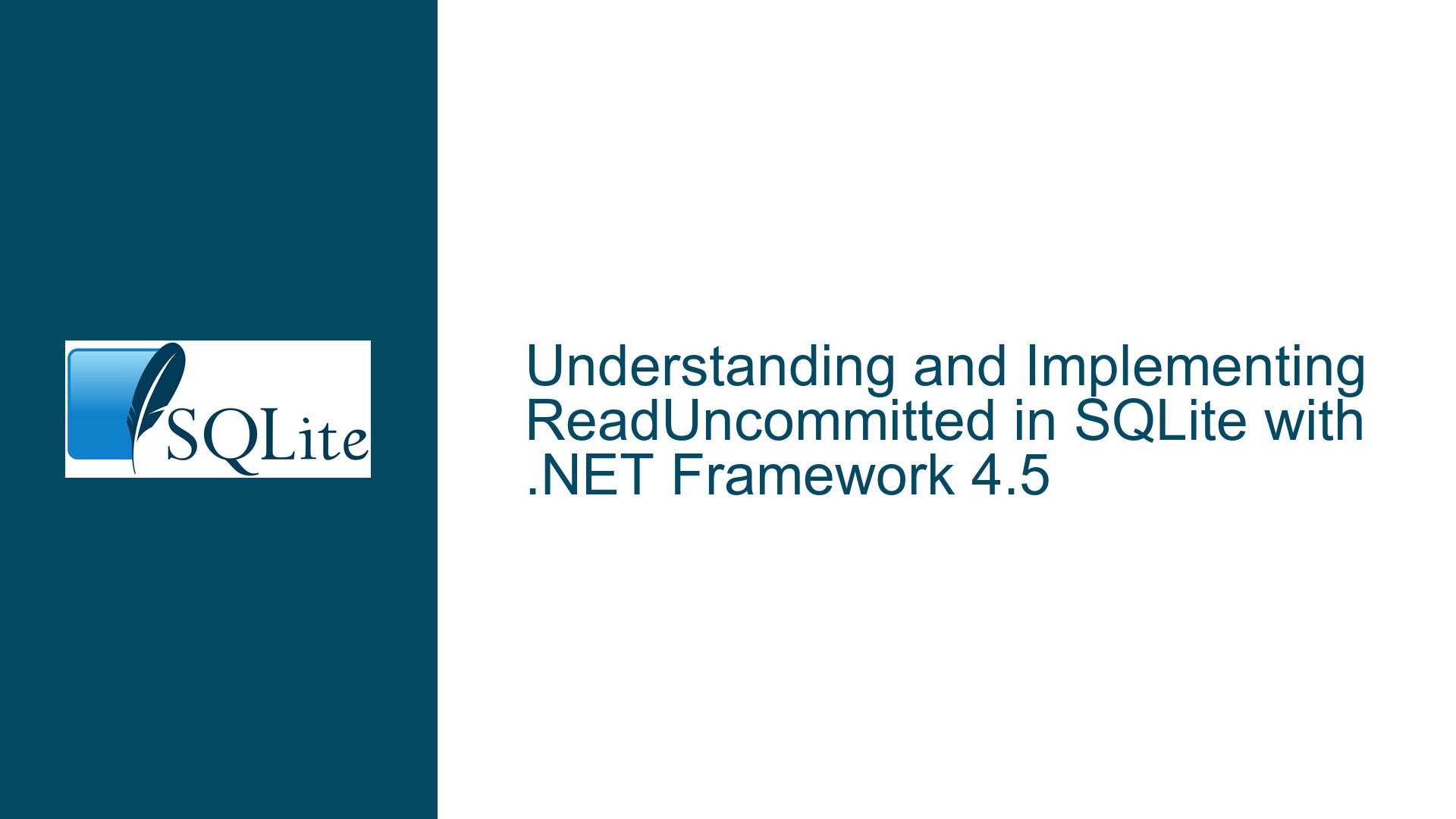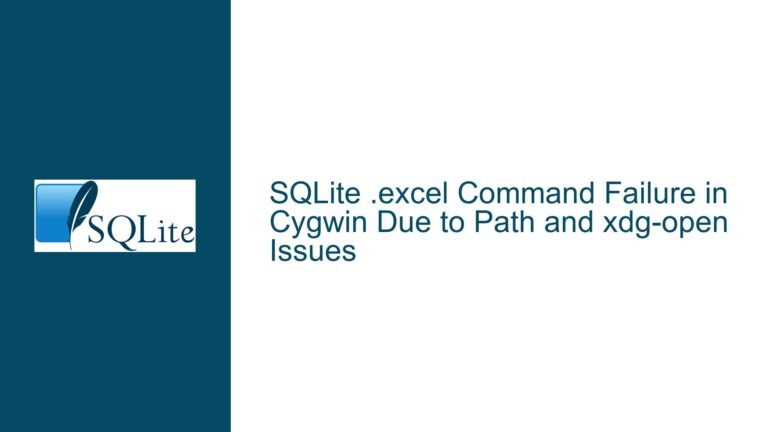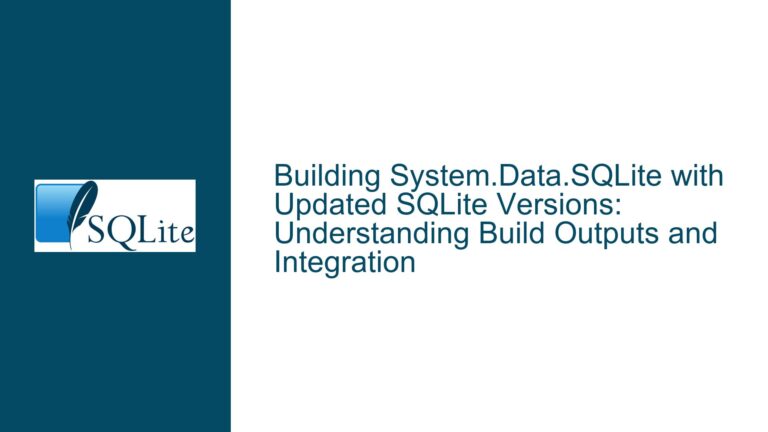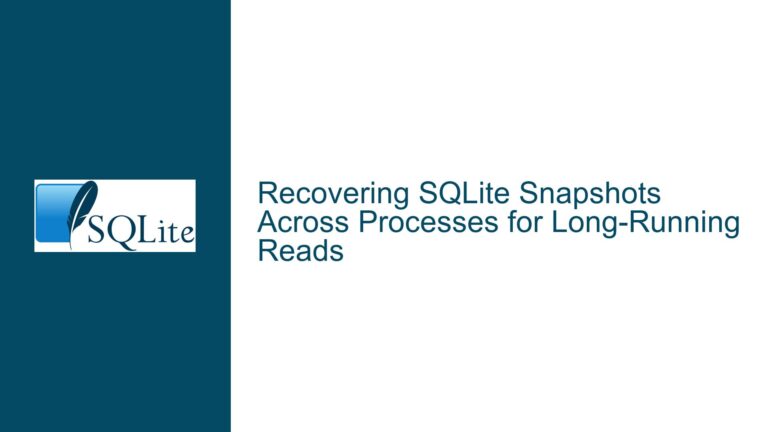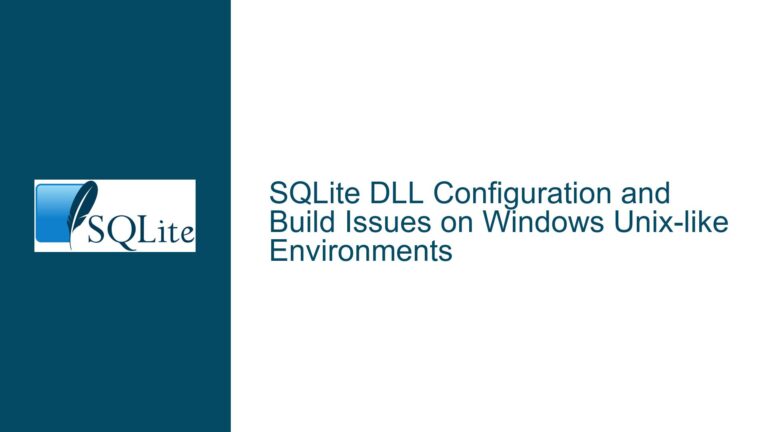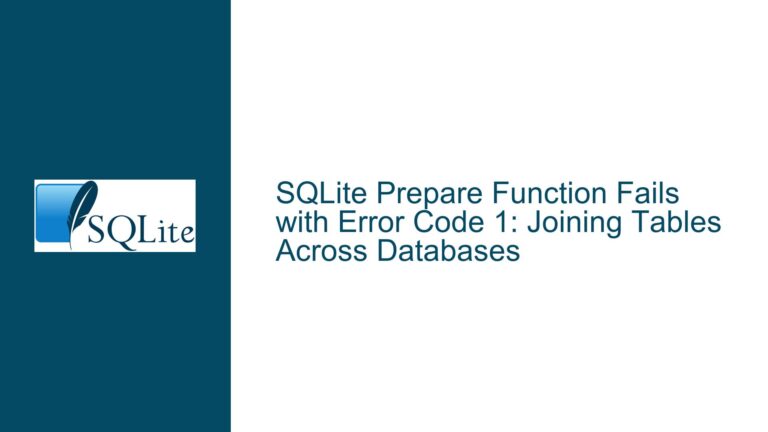and Implementing ReadUncommitted in SQLite with .NET Framework 4.5
Issue Overview: SQLite ReadUncommitted Isolation Level and Shared Cache Mode in .NET Framework 4.5
The core issue revolves around the implementation and validation of the ReadUncommitted isolation level in SQLite when using the .NET Framework 4.5. The goal is to allow one database connection to see uncommitted changes made by another connection, which is a feature supported by SQLite under specific conditions. The primary challenge lies in the fact that the System.Data.SQLite library, which is commonly used for SQLite interactions in .NET, does not support shared cache mode. This limitation prevents the ReadUncommitted pragma from functioning as expected, leading to the failure of unit tests designed to validate this behavior.
The unit test provided attempts to create a table, insert a row, and then read the uncommitted data from a second connection. However, the test fails with the error "no such table: Message," indicating that the second connection cannot see the changes made by the first connection. This failure is not due to the SQLite engine itself but rather due to the limitations of the .NET library being used.
Possible Causes: Why ReadUncommitted Fails in .NET Framework 4.5 with SQLite
The failure of the ReadUncommitted isolation level in the provided unit test can be attributed to several factors, primarily revolving around the limitations of the System.Data.SQLite library and the configuration of the SQLite database connections.
Lack of Shared Cache Mode Support in System.Data.SQLite: The
System.Data.SQLitelibrary does not support shared cache mode, which is a prerequisite for theReadUncommittedpragma to function correctly. Shared cache mode allows multiple connections to share the same cache, enabling one connection to see uncommitted changes made by another connection. Without this support, theReadUncommittedpragma has no effect, and each connection operates in complete isolation.Transaction Scope and Table Visibility: In the provided unit test, the table creation and insertion are performed within a transaction that is never committed. When the second connection attempts to read from the table, it cannot see the uncommitted changes because the transaction is still active. Even if shared cache mode were supported, the second connection would not be able to see the uncommitted changes unless the
ReadUncommittedpragma was correctly configured and the changes were made visible through shared cache mode.Misconfiguration of Connection String: The connection string used in the unit test includes the
read_uncommitted=trueparameter, but this parameter is ineffective without shared cache mode. The connection string also includesCache=Shared, which is intended to enable shared cache mode. However, this setting is not supported by theSystem.Data.SQLitelibrary, rendering it ineffective.Transaction Isolation Level Misunderstanding: The unit test attempts to use the
ReadUncommittedisolation level by setting it on the second connection. However, the isolation level is not correctly applied due to the lack of shared cache mode support. The isolation level setting is ignored, and the second connection operates with the default isolation level, which does not allow reading uncommitted changes.
Troubleshooting Steps, Solutions & Fixes: Achieving ReadUncommitted Behavior in .NET Framework 4.5 with SQLite
To address the issue and achieve the desired ReadUncommitted behavior in SQLite with .NET Framework 4.5, several steps and solutions can be considered. These steps involve understanding the limitations of the System.Data.SQLite library, exploring alternative libraries, and configuring the SQLite database connections correctly.
Understanding the Limitations of System.Data.SQLite: The first step is to recognize that the
System.Data.SQLitelibrary does not support shared cache mode, which is essential for theReadUncommittedpragma to function. This limitation means that theReadUncommittedisolation level cannot be achieved using this library. Developers must either accept this limitation or explore alternative libraries that support shared cache mode.Exploring Alternative Libraries: One possible solution is to use an alternative SQLite library for .NET that supports shared cache mode. Libraries such as
Microsoft.Data.SqliteorSQLitePCL.rawmay offer better support for shared cache mode and theReadUncommittedpragma. These libraries are more actively maintained and may provide the necessary features to achieve the desired behavior.Configuring Shared Cache Mode: If an alternative library that supports shared cache mode is used, the next step is to configure the SQLite database connections correctly. This involves setting the
Cache=Sharedparameter in the connection string and enabling theReadUncommittedpragma. The connection string should be configured as follows:var connectionString = $"Data Source={_dbFile};Cache=Shared;";Additionally, the
ReadUncommittedpragma should be enabled on each connection that needs to read uncommitted changes:using (var connection = new SQLiteConnection(connectionString)) { connection.Open(); using (var command = connection.CreateCommand()) { command.CommandText = "PRAGMA read_uncommitted = 1;"; command.ExecuteNonQuery(); } }Committing Table Creation Before Reading: In the provided unit test, the table creation and insertion are performed within a transaction that is never committed. To ensure that the table is visible to other connections, the table creation should be committed before attempting to read from it. This can be achieved by committing the transaction after creating the table:
using (var firstConnection = new SQLiteConnection(connectionString)) { firstConnection.Open(); using (var firstTransaction = firstConnection.BeginTransaction()) { using (var createTable = firstConnection.CreateCommand()) { createTable.CommandText = "CREATE TABLE Message(Text TEXT);"; createTable.ExecuteNonQuery(); } firstTransaction.Commit(); } }Validating ReadUncommitted Behavior: Once the shared cache mode and
ReadUncommittedpragma are correctly configured, the unit test can be updated to validate theReadUncommittedbehavior. The updated test should ensure that the second connection can see the uncommitted changes made by the first connection:[TestMethod] public void Test_Read_Uncommitted() { var connectionString = $"Data Source={_dbFile};Cache=Shared;"; using (var firstConnection = new SQLiteConnection(connectionString)) { firstConnection.Open(); using (var firstTransaction = firstConnection.BeginTransaction()) { using (var createTable = firstConnection.CreateCommand()) { createTable.CommandText = "CREATE TABLE Message(Text TEXT);"; createTable.ExecuteNonQuery(); } firstTransaction.Commit(); } using (var firstTransaction = firstConnection.BeginTransaction()) { string message = "Hello World!"; using (var insertRow = firstConnection.CreateCommand()) { insertRow.CommandText = $"INSERT INTO Message (Text) VALUES ('{message}');"; insertRow.ExecuteNonQuery(); } using (var secondConnection = new SQLiteConnection(connectionString)) { secondConnection.Open(); using (var command = secondConnection.CreateCommand()) { command.CommandText = "PRAGMA read_uncommitted = 1;"; command.ExecuteNonQuery(); } using (var queryCommand = secondConnection.CreateCommand()) { queryCommand.CommandText = "SELECT Text FROM Message;"; var messageActual = (string)queryCommand.ExecuteScalar(); Assert.IsTrue(string.CompareOrdinal(message, messageActual) == 0); } secondConnection.Close(); } firstTransaction.Rollback(); } firstConnection.Close(); } }Handling Edge Cases and Error Conditions: It is important to handle edge cases and error conditions when working with
ReadUncommittedisolation level. For example, if the second connection attempts to read from a table that does not exist or has been dropped, appropriate error handling should be in place. Additionally, developers should be aware of the potential for dirty reads and the implications of reading uncommitted data.Performance Considerations: Using shared cache mode and the
ReadUncommittedpragma can have performance implications, especially in high-concurrency environments. Developers should carefully consider the trade-offs between performance and the need for reading uncommitted data. In some cases, it may be more appropriate to use a different isolation level or to redesign the application to avoid the need for reading uncommitted data.Testing and Validation: Finally, thorough testing and validation are essential to ensure that the
ReadUncommittedbehavior works as expected. This includes unit tests, integration tests, and stress tests to validate the behavior under different conditions. Developers should also monitor the application in production to ensure that theReadUncommittedisolation level does not introduce unexpected issues.
In conclusion, achieving the ReadUncommitted isolation level in SQLite with .NET Framework 4.5 requires a deep understanding of the limitations of the System.Data.SQLite library, careful configuration of the SQLite database connections, and thorough testing and validation. By following the steps and solutions outlined above, developers can overcome the challenges and achieve the desired behavior in their applications.
